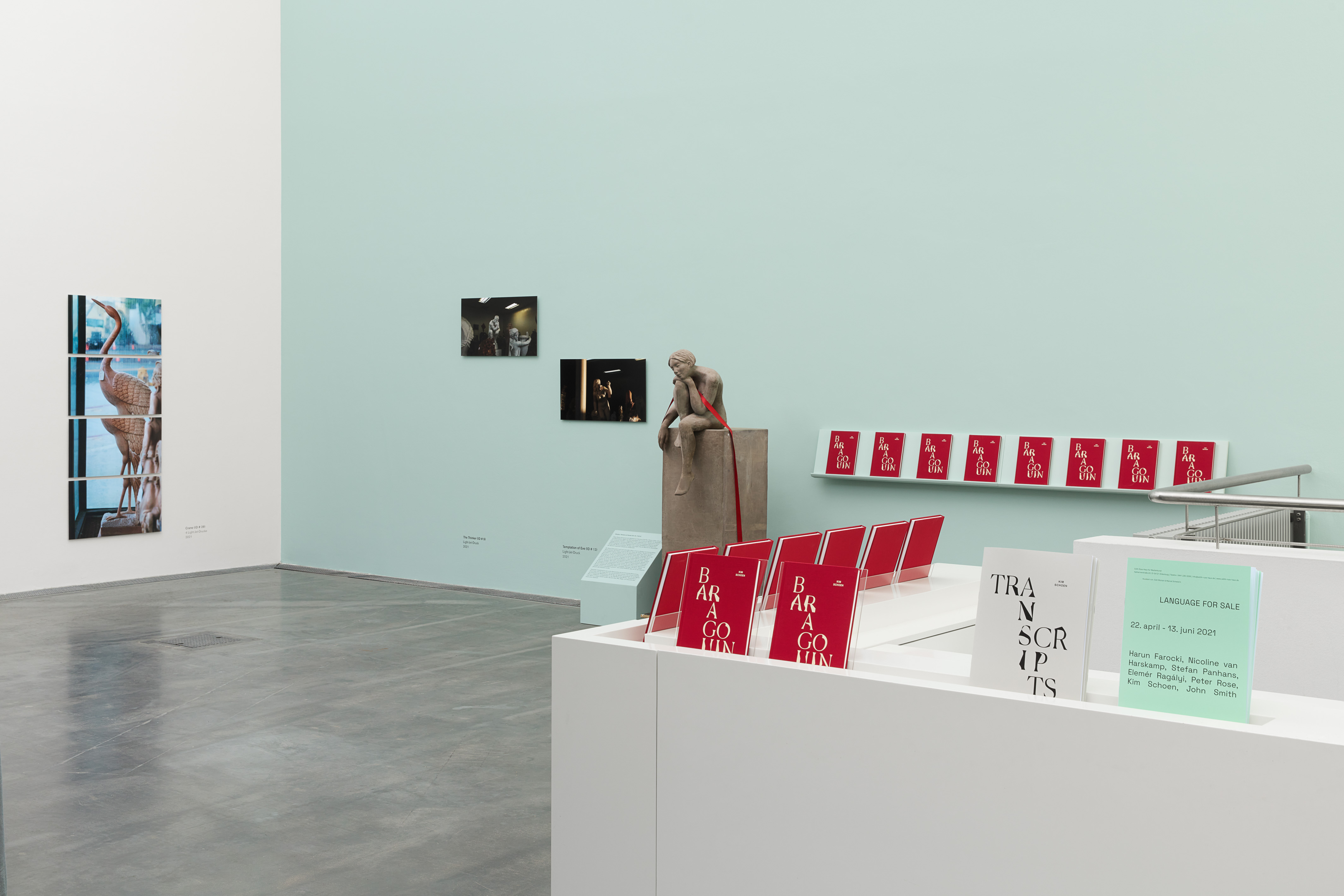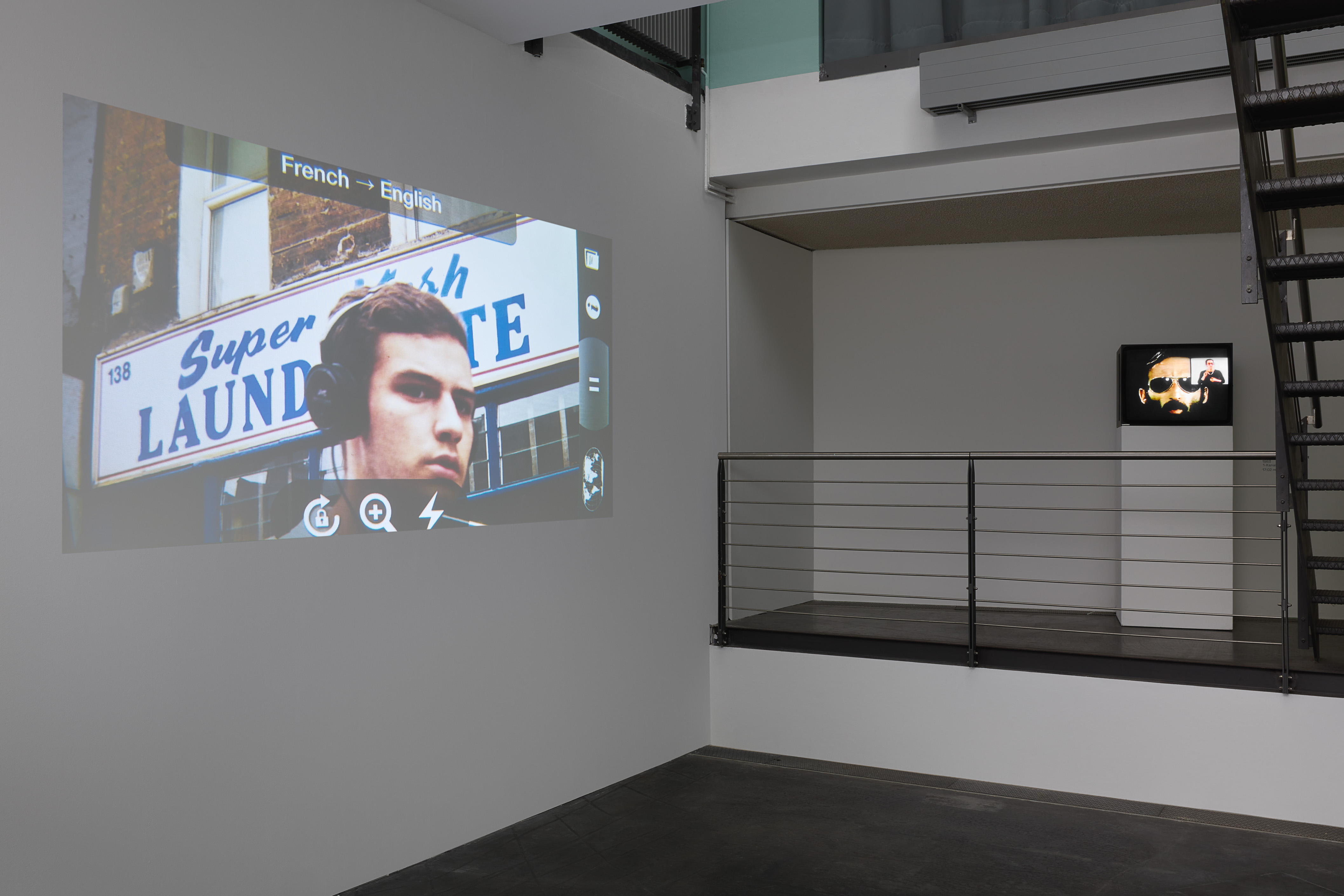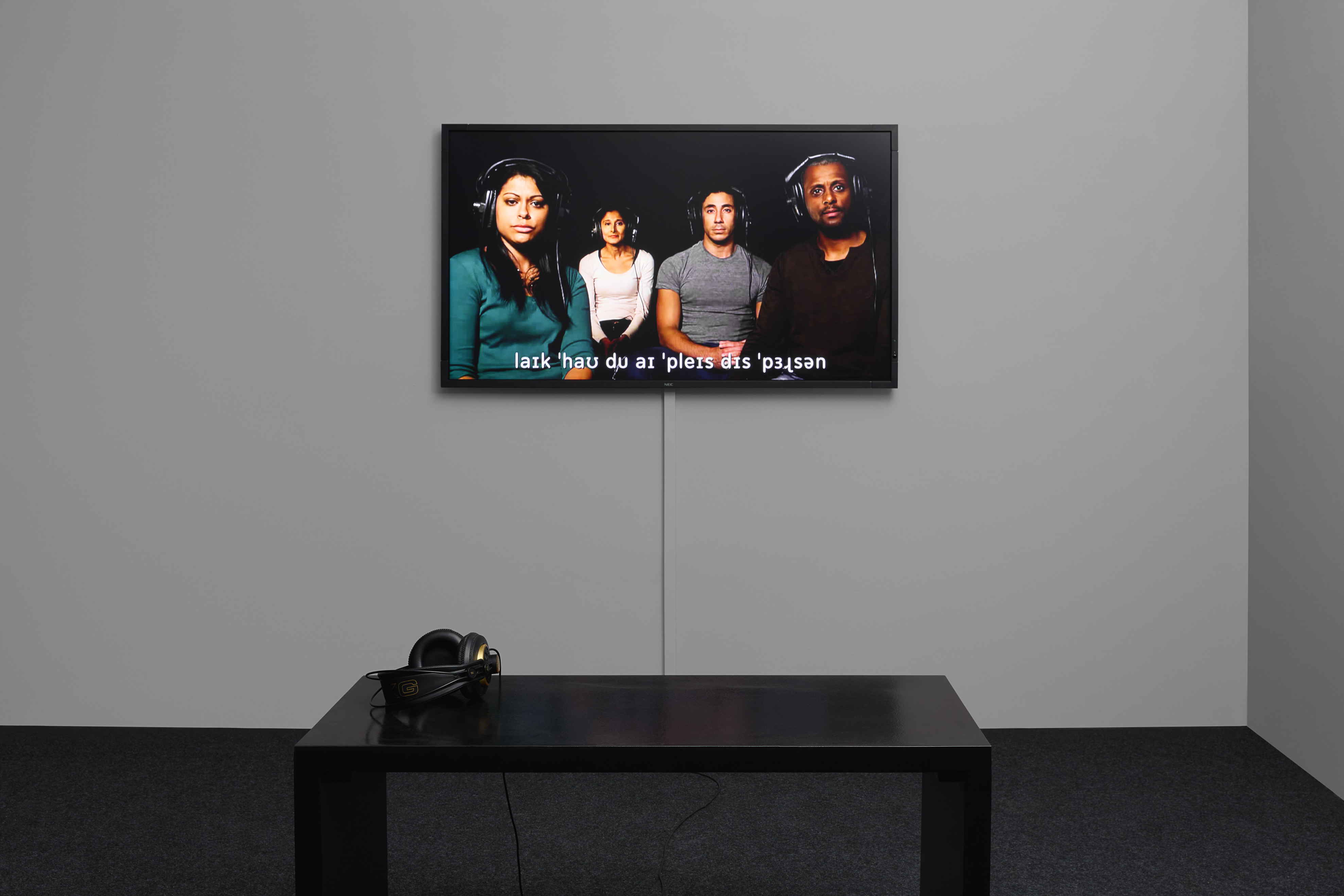Language for Sale
The international group exhibition Language for Sale puts nonsense at its center. Laced with humor, the exhibited works engage with rhetorical and linguistic moments of transition—a change marked by the increasing appearance of nonsense language.
The exhibition was inspired by Kim Schoen’s newly commissioned work Baragouin (2021). Having explored the topics of nonsense and repetition for years, Schoen premieres this most recent experimental installation—named after the French term for “unintelligible jargon”—as part of Language for Sale. Baragouin gives voice to objects the artist filmed in a commercial showroom in Los Angeles that sold copies of sculptures ranging from Buddhist to Rococo and neoclassical to modernist. Working with the assumption that international commerce creates a lingua franca of its own, Schoen mounts a “nonsense opera” in which the knockoff sculptures appear to “speak” in voices relating to the provenance of their assumed originals.
Rhetoric as persuasive public language and its current crisis is also a focus of the other works in the exhibition. Rhetoric—which can simplify the complex, which we use to inspire and influence others—is a difficult performative genre. Political rhetorical culture is currently undergoing profound changes, witnessed in today’s speeches and communiqués. Several pressures on rhetorical culture are changing the climate of speech: from mistrust in politicians, to the deterioration of attention spans, to anger-driven social media use. But it is the decline of institutions of open debate and of access to longer argumentative forms that have ushered in the most profound change in political communication: the transforming role of the lie, morphing from a secretly used weapon into an openly used tool of propaganda.
Language for Sale tracks several ideological changes from the 1970s up to now, demonstrated through the use of public language, and looks at the performative challenges that speakers try to overcome to master these transitions.
Elemér Ragályi’s documentary film Szónokképző iskola (Speakers training course), made in Hungary in 1972, follows a course preparing public speakers to lead funeral ceremonies. The film reveals the contrast between the real human emotions involved in such events and the painful inadequacy of the social celebrations that were hastily invented to replace traditional, mostly religious ceremonies in socialist Hungary. In the context of the exhibition, Ragályi’s film acts as a keystone because of its sensitivity toward the hardships and comical possibilities of rhetorical situations in a complicated and shifting ideological context.
Another documentary work that examines educational courses as a way to investigate shifting times and the comical possibilities of unintentional nonsense is Harun Farocki’s documentary Die Schulung (Indoctrination), 1987. It looks at a five-day seminar designed to teach executives and managers how to “sell themselves” better. Merchants have always aimed to sell something, but only through the marriage of psychology and modern capitalism did the idea of selling oneself emerge—helping to usher in neoliberalism.
Peter Rose’s video Pressures of the Text (1983) elaborates on the boundary between meaning and meaninglessness in art-related speech and critical writing. It integrates direct address, invented languages, ideographic subtitles, sign language, and simultaneous translation to investigate the feel and form of sense-making, that is to say, the shifting boundaries between meaning and meaninglessness. A parody of art- or crit-speak, educational instruction, gothic narrative, and pornography, Pressures of the Text has also been performed as a live work in the US and Europe.
Stefan Panhans makes elaborate video pieces whose sets are worked out in meticulous detail while their protagonists’ actions are kept to a bare minimum. In Sieben bis zehn Millionen (Seven to ten million) 2005, a young man sporting hip-hop headwear and a fur-lined hood stares into the camera, as if in a music video, while performing a hysterical staccato monologue reporting on the predicament of purchasing an unnamed digital device. He bemoans the exhausting “labor of consumption”—the daily bewilderment and surges of paranoia wrought by the electronics market, elevating the purchasing decision to an existential one that is all but religious in status.
John Smith’s Steve Hates Fish (2015) ridicules one of the newest inventions in language softwares, the automatic translation using artificial intelligence. Filmed directly from the screen of a smartphone using a language translator app that has been told to translate from French into English, the artist deliberately confuses the software by instructing it to interpret the English signage in a busy London shopping street—with hilarious results.
The ever-changing status of the dominant language of global exchange—that is, the English language—is at the center of Nicoline van Harskamp’s video English Forecast (2013) and the “Massive Online Open Course” project Englishes Mooc (2019−). English Forecast, presenting a performance and interactive media piece commissioned by Tate Modern, London, follows a team of four actors reciting what van Harskamp has identified as the possible future sounds of the English language. The dialogue, pinched from actual conversations, sways disjointedly from welcoming acceptance to words of caution. Noting the threat a dominant lingua franca poses to other languages, the artist suggests the work is as much “a discussion about the preservation of languages” as it is about their adaptation and potential disintegration. Englishes Mooc is an online course developed for young art makers and their audiences. It wants them to stop measuring their English along a ‘native’ standard in the international realm. When adapted according to the needs of its users, new varieties of English can emerge. The project helps to develop practical skills towards this with pre-recorded lectures and with a platform for live discussion.
Kim Schoen was the 2019 recipient of the Media Art Grant from the Foundation of Lower Saxony at the Edith-Russ-Haus.
Curated by Edit Molnár & Marcel Schwierin.
The info booklet on the exhibition with brief descriptions of all exhibited works can be downloaded free of charge as a PDF. The use is exclusively for private purposes, other uses must be coordinated with the Edith-Russ-Haus. Download here.
 YouTube:
YouTube:
Activate service and agree with the data transfer to YouTube.Informations to the privacy policy and the release revocation you will find here: Datenschutzerklärung YouTube:
YouTube:
Activate service and agree with the data transfer to YouTube.Informations to the privacy policy and the release revocation you will find here: Datenschutzerklärung YouTube:
YouTube:
Activate service and agree with the data transfer to YouTube.Informations to the privacy policy and the release revocation you will find here: Datenschutzerklärung Vimeo:
Vimeo:
Activate service and agree with the data transfer to Vimeo.Informations to the privacy policy and the release revocation you will find here: Datenschutzerklärung





















